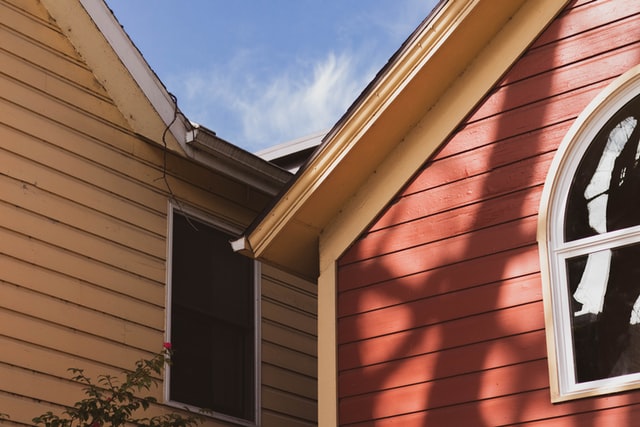
Installing gutters is an investment that pays you back by protecting your property in several ways. When you’re budgeting for this project, it can help to know how long gutters last. Knowing the lifespan of your gutters can also help you coordinate other home improvement projects, such as replacing your roof or adding solar panels.
Lifespan of Different Types of Gutters
The average gutter lasts 20 to 25 years before it needs to be replaced. But the material makes a difference in the gutter’s longevity. Heavy-duty materials that are resistant to weathering last longer than flimsy gutters.
You can expect different levels of durability from the following gutter materials.
Vinyl
Vinyl gutters are popular for their affordability and easy installation. But vinyl is the least durable gutter material. It can last up to 20 years in mild, dry climates. However, it should be replaced within 10 to 15 years in locations with ample wind, rain or snowfall.
You don’t have to worry about corrosion with vinyl like you do with some metals. But sun and water damage can make vinyl brittle over the years, increasing the likelihood that it will break.
Aluminum
Aluminum gutters combine affordability with reliability. They’re made from a relatively sturdy metal and generally last about 25 years.
This material is rust-resistant. Although it isn’t as thick or rigid as other metals, aluminum won’t wear away easily when it’s exposed to the elements. However, it’s susceptible to dents, which may impair the function of the gutters.
You can install aluminum gutters in any climate. But fluctuating temperatures can compromise their integrity, increasing their chances of splitting and cracking.
One of the benefits of aluminum gutters is their light weight. But the downside of this feature is that the gutters may bend easily. Seamless aluminum gutters fare better than segmented styles. Because they have fewer weak spots, they’re less vulnerable to bending.
The enamel coating on aluminum gutters adds another layer of protection. Repainting the gutters when the original finish starts to wear away can extend their life.
Zinc
Zinc is even more durable than aluminum and lasts about 50 years. It’s usually available as an alloy that contains 1% titanium and 99% zinc. Because the seams on zinc gutters must be welded, they’re especially sturdy.
Pre-weathered zinc has a patina that protects it from deteriorating from exposure to the elements. The patina also delivers a unique natural look that is difficult to replicate with paint.
Galvanized Steel
Galvanized steel gutters are made of steel with a zinc coating. They last about the same length of time as aluminum, which is an average of 20 years.
Some homeowners prefer galvanized steel gutters to other materials because they withstand changes in temperature better than aluminum and don’t dent easily.
Galvanized steel gutters require more maintenance than aluminum. They can rust if the zinc coating is compromised. Therefore, it’s important to inspect and repair them as necessary.
Stainless Steel
Stainless steel gutters are naturally rust-resistant and last up to 50 years. They don’t have a coating to keep up with. However, they’re heavier than aluminum and galvanized steel.
Still, stainless steel gutters nave numerous benefits. They’re not corrosive and require little maintenance. They’ll stay shiny and durable for years.
But this is one of the least popular materials for gutters. It’s relatively expensive and difficult to install.
What Affects How Long Your Gutters Last?
In many cases, you get what you pay for. High-quality materials require more resources to produce. Therefore, they are generally more expensive than lower quality alternatives.
But installation plays a major role in how long your gutters last. Using an expert to install your gutters ensures that they are appropriate for your type of roof. Professional installation also ensures the security and stability of the gutters and downspouts.
Maintenance also plays a major role in your gutters’ longevity. You should clean and inspect your gutters at least twice a year. Removing large debris and particles that clog the downspouts prevents sagging, detachment, pooling, leaks and corrosion. Checking the gutters for damage allows you to spot fix the problem as soon as possible and prolong their life.
Seamless and welded gutters have fewer weak spots throughout their length. They’re less likely to bend and have a longer lifespan than gutters with joints.
Considerations When Choosing Gutters
Using gutter longevity as a factor in your decision-making can help you get the most out of your new gutters. But there are some other things to consider when selecting the best gutters for your home.
Beware of Combining Materials
The combination of certain materials can impair the durability of your gutters. The tannins in some cedar roofs, for example, are water-soluble acids that cause zinc to corrode prematurely.
The runoff from copper also deteriorates zinc. Galvanized steel, on the other hand, doesn’t react to runoff from other materials and can be used with any roofing product. If you have a metal roof, your options for metal gutters might be limited.
Should You Get a New Roof and Gutters at the Same Time?
People often wonder whether the lifespan of their gutters should match that of the roof. If your roof will only last 25 years, is it worth it to invest in gutters that will span a century? Logistically and financially, it makes the most sense to coordinate your gutters with your roof, installing products with a similar lifespan at the same time. But that’s not always possible.
However, it’s not a major concern. In many cases, the gutters can remain attached to the wood fascia, making it possible to replace the roof without affecting the gutters. In other instances, the roofers can remove the existing gutters, install the roof and re-install your gutters.
